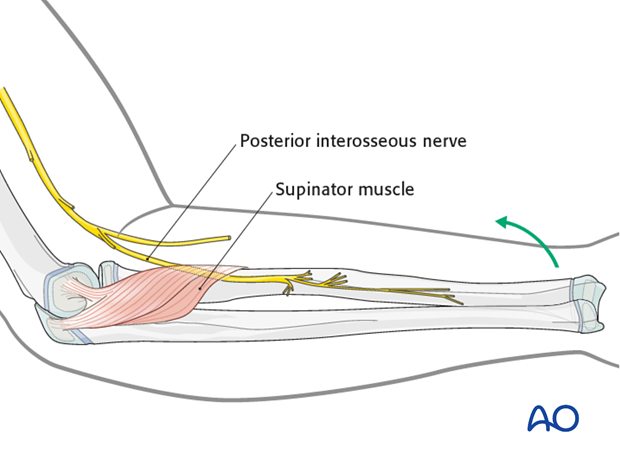nalco group
bone, muscle & joint pain physio
BOOK NOW / WHATSAPP ABOUT YOUR PAIN OR INJURY
- NOVENA 10 Sinaran Drive, Novena Medical Center #10-09, Singapore 307506
- TAMPINES 9 Tampines Grande #01-20 Singapore 528735
- SERANGOON 265 Serangoon Central Drive #04-269 Singapore 550265
Home > Blog > Physiotherapy & Hand Therapy > Conditions > Shoulder Pain / Elbow Pain > Posterior Interosseous Nerve Entrapment Elbow Pain Physiotherapy
Posterior Interosseous Nerve Entrapment Elbow Pain Physiotherapy

Posterior interosseous nerve syndrome is basically a pathology that involves the posterior interosseous nerve. It’s characterized by motor weakness and/or pain that occurs due to nerve compression.
In certain parts of the medical community, Posterior Interosseous Nerve (PIN) Syndrome and Radial Tunnel Syndrome are regarded as the same condition, whereas in other parts, they’re considered different diagnoses that are associated with the same nerve.
In this blog, we’ll take an in-depth look at:
- The causes and symptoms of the PIN syndrome
- Common treatment options for this elbow condition
first of all, What is the Posterior Interosseous Nerve?
The posterior interosseous nerve is situated near the shaft of the elbow and the humerus and it’s commonly known as the deep branch of the radial nerve.
The radial nerve branches into a posterior interosseous branch and a superficial branch and provides most of the hand and forearm extensors.

If the deep branch becomes entrapped in the supinator arch, it can lead to the entrapment of the posterior interosseous nerve. It’s worth considering that the PIN syndrome usually develops spontaneously, and it starts with the weakening of the muscles in the wrist and digital extensors.
Additionally, this condition is typically known to be painless and patients that have isolated PIN syndrome won’t experience a sensory deficit.
What Causes the Entrapment of the Posterior Interosseous Nerve?
The posterior interosseous nerve syndrome happens due to compression injuries or stretching that can occur as the nerve passes under the supinator muscle (Arcade of Fohse) in the forearm. It can be caused by entrapment if the supinator muscle is unusually large or tight or due to adhesions between the muscle and the nerve.
Common causes of the posterior interosseous nerve entrapment are inflammation, tumors, an anatomic injury, and a traumatic injury. It can also be caused by activities that involve repetitive up and down orientation of the elbow or hand and extension of the wrist.
Moreover, it can result from space-occupying lesions (as in rheumatoid arthritis), spontaneous compression, brachial neuritis, as well as trauma (for instance, receiving a blow to the proximal dorsal region of your forearm).
Among some other causes of entrapment of posterior interosseous nerve are extrinsic compression and nerve abnormalities.
Common Symptoms of Posterior Interosseous Nerve Entrapment
It’s important to note that posterior interosseous nerve entrapment usually doesn’t get better with time if the identified cause of the syndrome isn’t treated effectively. If you think you may have this syndrome, you should consider getting in touch with a professional therapist. In the meantime, it’s advisable to avoid engaging in activities that may worsen the symptoms and result in further entrapment.
It’s also observed that a patient with this syndrome generally has a history of fracture or trauma around that region. The PIN syndrome can occur in radial head fracture dislocations as well as Monteggia fractures.
Some common symptoms include showing signs of weakness while extending the fingers and a positive Tinel sign at the area of injury (depending on how severe it is).
Moreover, it’s expected that the symptoms will develop gradually, and their duration can be an average of two to three years until the condition becomes clear and a definitive diagnosis is made.
Most symptoms of this nerve entrapment typically consist of motor and sensory changes, pain, paresthesia (burning or prickling sensation, paresis, and sensations of snapping and popping. Pain felt on the outside of the forearm a little below the elbow joint is known to be quite common. A simple turning of the forearm where the palm is facing upward can cause the pain to worsen.
Some other symptoms are:
- Weakness
- Stiffness
- Spasm
- Numbness
- Inflammation/swelling
- Tingling sensation (like pins and needles)
- Limitation of movement
Even though the posterior interosseous nerve entrapment doesn’t generally lead to long-term effects, especially if it’s diagnosed and treated appropriately, it can result in chronic pain in the elbow if it’s left untreated.
This can cause you to take a prolonged break from sport and exercise.
In some cases, long-term effects may occur even after proper treatment and surgery may become necessary to eliminate the structures that have caused the nerve entrapment and relieve pain.
Some complications you should consider include the inability to perform jobs that are physically demanding, continuation of symptoms, and incomplete decompression.
Who Is More at Risk of developing Posterior Interosseous Nerve Entrapment Elbow Pain?
The entrapment of the posterior interosseous nerve is known to occur more frequently in males as opposed to females, in a ratio of 2 to 1. It’s also found to happen twice as much in the right arm instead of the left one.
Moreover, around 3 out of 100,000 bodybuilders and manual laborers are more at risk of developing this syndrome. Among people with a humeral shaft fracture, there’s a 12 percent likelihood ofradial nerve paralysis.
differential diagnoses: Conditions Similar to Posterior Interosseous Nerve Entrapment
If you feel any pain in your hand, elbow, or arm, it’s imperative that you talk to your health care provider instead of starting a treatment for this condition on your known. This is due to the fact that the posterior interosseous nerve syndrome shares quite a lot of similarities with a variety of elbow conditions. Two of these are Wartenburg syndrome and radial tunnel syndrome.
Wartenburg Syndrome
Also referred to as ‘cheiralgia paresthetica’, this syndrome is essentially a compression of the superficial branch of the radial nerve.
Since this sensory nerve doesn’t have any motor innervation, the symptoms are known to be completely sensory, which means there won’t be any motor weakness that’s usually expected in the PIN syndrome.
Patients may exhibit signs of numbness, paresthesia, or ill-defined pain over the radial aspect of the hand.
The Wartenberg Syndrome is also associated with De Quervain tenosynovitis.
Even though the causes of posterior interosseous nerve syndrome and radial tunnel syndrome are quite similar and radial tunnel syndrome is associated with the same region of compression, the latter is known to cause forearm pain with the absence of motor weakness.
It’s also common to experience tenderness in the muscles of the posterior compartment of the forearm, which is also sometimes mistaken for lateral epicondylitis.
Posterior Interosseous Nerve Treatment Options
A variety of special investigations are utilized in order to make the diagnosis for posterior interosseous nerve syndrome so it can be treated effectively. These investigations will also help determine the severity of the condition.
They include:
- Nerve conduction velocity
- Electromyography (to determine the level of nerve compression)
- MRI (not common, used to identify the area of compression and assist in surgical planning)
Fortunately, due to medical advancements, there are many ways the entrapment of the posterior interosseous nerve can be treated. Once the space-occupying lesions are removed, initial treatment usually involves rest, modification techniques, physical therapy, splinting and NSAIDs.
In case of a compressive lesion, surgical intervention may be necessary, which is typically only carried out when symptoms are unmanageable and initial treatment doesn’t prove to be satisfactory within three months.
Surgical decompression is considered, which basically focuses on removing the areas of compression. Other operative treatments may include neurorrhaphy, tendon transfer, and external and interfascicular neurolysis.
After surgery is performed, the patient is required to begin an early active range of movement. The symptoms will continue to improve in the months following the surgery.
How our hand therapists and Physiotherapists Can Help People with Posterior Interosseous Nerve Syndrome
Since the entrapment of the posterior interosseous nerve occurs when the deep branch of the radial nerve gets caught under the supinator arch as it passes along the outside of the forearm or the elbow, physiotherapy can be considered as an important part of treatment for this syndrome.
In the initial stages, we will take time to properly diagnose the condition and determine the severity of the symptoms. This may require the help of special nerve conduction tests that are meant to assess how well the signals are transmitted along the nerve.
After the assessment is carried out, your physiotherapy will come up with an effective treatment plan for you, which may involve soft tissue treatment like massage, stretching, and electrotherapy, as well as activity modification.
They will also identify what caused you to develop posterior interosseous nerve syndrome so they can actively prevent it from happening again when you finally return to sport and exercise.
Other physiotherapy treatment options include:
- Taping
- Ergonomic assessment
- Mobilization/manipulation
- Manual therapy
- Postural realignment
- Exercise programs
- Ultrasound physiotherapy to accelerate nerve and soft tissue healing
Do you suspect that you have entrapment of the posterior interosseous nerve?
Instead of treating it yourself or waiting for the symptoms to get worse, you should get in touch with our experts at Phoenix Rehab. They are trained in a variety of strengthening and stretching exercises that will help you heal naturally.
They’re qualified to perform extensive posterior interosseous nerve tests to determine which treatment option will yield the best results for you. They may also employ ultrasound therapy to help alleviate pain and discomfort, depending on the severity of your condition.
We will also assess to determine if it's other issues that's causing your elbow pain.
Are you looking to learn more about PIN syndrome and how you can prevent it from occurring? Get in touch with us now!
